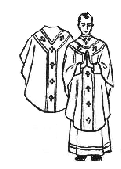

Holy Trinity
Amblecote
Vestments
The stole symbolises the clerical office, immortality, and the Yoke of Christ. This, matching the liturgical colour, is a long, scarf-
The chasuble symbolises charity and the Yoke of Christ. This matches the liturgical colour and is a long, often ornate, sleeveless poncho-

The Cope Worn by the Priest or Deacon for non-
The Cassock The black cassock worn by most Priests in many different situations is of no special significance other than as a means of identification. Part of its significance is that it covers up and, to some extent, hides the individualism of the Priest and proclaims to all that he is a Priest of the Church.
Liturgical Vestments
The robes worn for the Eucharist are an adaptation of the ordinary clothes worn at the time of the Roman Empire. When those clothes were no longer worn everyday priests continued to wear them. These clothes tended to be left in Church and simply put on for services. This happened over time and it is almost by accident that they have come to be associated with priesthood and the Eucharist.
When vesting for the liturgy the priest first washes his hands, praying: Give virtue to my hands, O Lord, that being cleansed from all stain I might serve you with purity of mind and body.
The alb is the long white, robe-


The girdle which is a symbol of chastity, ties the alb at the waist.
The cleric prays: Gird me, O Lord, with the girdle of purity, and extinguish in me all evil desires, that the virtue of chastity may abide in me.
 Go to top
Go to top

The Collar The distinctive collar worn by most clergy is known by a number of names Clerical, Roman or Dog being the best. It closes at the back of the neck, presenting a seamless front. The shirt may have the collar built in. The clerical collar is almost always white and was originally made of cotton or linen but is now frequently made of plastic. It is claimed that although called a Roman collar it was a protestant invention of the late nineteenth Century.
The person credited for the introduction of the detachable white collar was the Reverend Donald McLeod, a Church of Scotland or Presbyterian minister, in Glasgow in 1865. He combined this with the white preaching bands which had been worn by Protestant Clergy for some time.
There has been some discussion of late concerning the wisdom of the clergy wearing such a distinctive form of dress. Vicars have been told to stop wearing dog-
A report called ‘The Clergy Lifestyle Theory’ published in 2007 warned clergy that the collars make them an "easy target" and says they should adopt more casual clothing in a bid to give them greater safety.
The report caused some controversy amongst the Clergy with the claim that “many feel torn when it comes to balancing the desire to be visible and approachable within their community against the importance of protecting their safety and personal time”.
Canon Paul Tongue’s booklet ‘Why?’ may prove helpful in explaining the reasons for the use of Vestments.